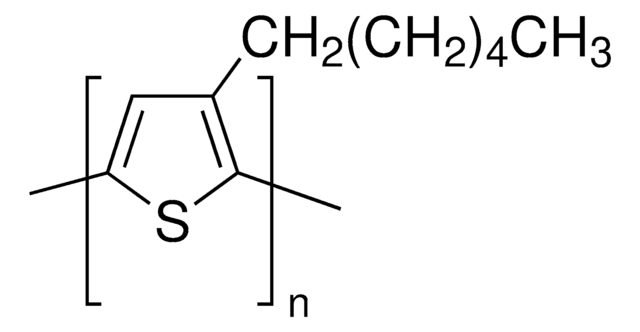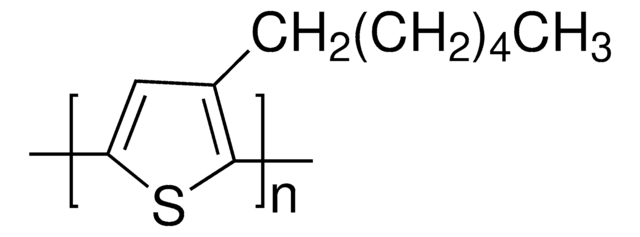Kluczowe dokumenty
772410
PTB7
average Mw 80,000-200,000, PDI ≤3.0
Synonim(y):
Poly({4,8-bis[(2-ethylhexyl)oxy]benzo[1,2-b:4,5-b′]dithiophene-2,6-diyl}{3-fluoro-2-[(2-ethylhexyl)carbonyl]thieno[3,4-b]thiophenediyl})
About This Item
Polecane produkty
opis
Band gap: 1.84 eV
Formularz
solid
masa cząsteczkowa
average Mw 80,000-200,000
charakterystyka ekologicznej alternatywy
Design for Energy Efficiency
Learn more about the Principles of Green Chemistry.
sustainability
Greener Alternative Product
rozpuszczalność
chlorobenzene: soluble
chloroform: soluble
dichlorobenzene: soluble
λmaks.
680 nm (thin film)
Energia orbitalna
HOMO -5.15 eV
LUMO -3.31 eV
Mw/Mn
2.4 +/- 0.6
PDI
≤3.0
kategoria ekologicznej alternatywy
, Enabling
Opis ogólny
Zastosowanie
OPV Device Structure: ITO/PEDOT:PSS/PTB7 :PC71BM/Ca/Al
- JSC = 14.9 mA/cm2
- VOC = 0.75 V
- FF = 0.69
- PCE = 7.4%
Kod klasy składowania
11 - Combustible Solids
Klasa zagrożenia wodnego (WGK)
WGK 3
Temperatura zapłonu (°F)
Not applicable
Temperatura zapłonu (°C)
Not applicable
Wybierz jedną z najnowszych wersji:
Masz już ten produkt?
Dokumenty związane z niedawno zakupionymi produktami zostały zamieszczone w Bibliotece dokumentów.
Produkty
The development of high-performance conjugated organic molecules and polymers has received widespread attention in industrial and academic research.
Organic photovoltaics (OPVs) represent a low-cost, lightweight, and scalable alternative to conventional solar cells. While significant progress has been made in the development of conventional bulk heterojunction cells, new approaches are required to achieve the performance and stability necessary to enable commercially successful OPVs.
Professor Chen (Nankai University, China) and his team explain the strategies behind their recent record-breaking organic solar cells, reaching a power conversion efficiency of 17.3%.
Nasz zespół naukowców ma doświadczenie we wszystkich obszarach badań, w tym w naukach przyrodniczych, materiałoznawstwie, syntezie chemicznej, chromatografii, analityce i wielu innych dziedzinach.
Skontaktuj się z zespołem ds. pomocy technicznej







![[6,6]-Phenyl C71 butyric acid methyl ester, mixture of isomers 99%](/deepweb/assets/sigmaaldrich/product/structures/716/624/9fb9f2f0-ae99-429f-8d3a-b12267976a4d/640/9fb9f2f0-ae99-429f-8d3a-b12267976a4d.png)